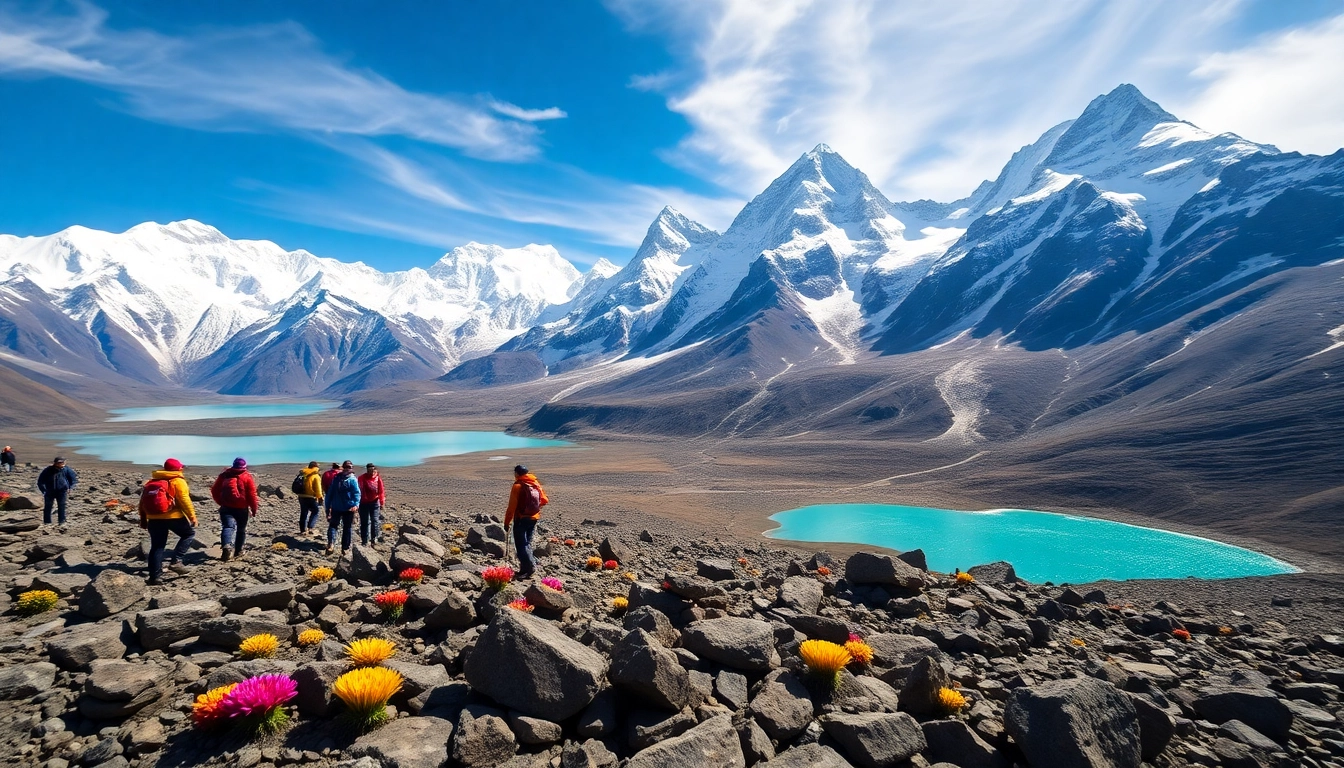Overview of Everest Base Camp via Gokyo Lakes Trek
The Everest Base Camp via Gokyo Lakes Trek is a journey that combines two of the most breathtaking landscapes in the world. Nestled in the heart of the Himalayas, this trek is designed for adventurers seeking a more scenic and less-trafficked route to the world-renowned Everest Base Camp. As trekkers traverse the diverse terrains—from lush valleys to high alpine lakes—the allure of Gokyo Lakes offers a stunning contrast to the imposing grandeur of Mount Everest. Not only does this trek provide an opportunity to view the majestic peak, but it also immerses travelers in the rich culture and traditions of the Sherpa community.
This trek often takes around 15 to 19 days, depending on the chosen itinerary, allowing ample time for acclimatization and exploration. Along the trail, trekkers encounter glacial lakes, rugged mountain vistas, and picturesque settlements that highlight the natural beauty and cultural significance of this region. For those looking to embark on an unforgettable adventure, the Everest Base Camp via Gokyo Lakes Trek promises an experience that is as challenging as it is rewarding.
What to Expect on the Trek
The Everest Base Camp via Gokyo Lakes Trek can be both challenging and exhilarating. Trekkers are advised to expect varying weather conditions, diverse landscapes, and the physical demands of high-altitude trekking. The progression from lower altitudes to higher elevations can bring about altitude sickness, making it crucial for trekkers to acclimatize properly. The trek includes numerous ascents and descents, and trekkers will experience a range of terrains from rocky paths to soft trails along grassy hills.
Additionally, encounters with local wildlife, including yaks and various bird species, add to the trek’s charm. As the journey unfolds, travelers have the opportunity to visit local monasteries, interact with the warm-hearted Sherpa people, and learn about their traditions. Overall, trekkers can expect an immersive experience that combines physical endurance with cultural enrichment.
Duration and Distance of the Trek
The total distance covered during the Everest Base Camp via Gokyo Lakes Trek is approximately 130 to 140 kilometers (around 81 to 87 miles). While the trekking duration varies, a typical itinerary spans 15 to 19 days. This includes travel days to reach Lukla—the starting point of the trek—as well as acclimatization days to allow trekkers to adjust to the altitude.
The trek is usually divided into sections, with each day involving 5 to 7 hours of trekking on average. Considering the elevation gain and the physical challenges, the trek is suited for physically fit individuals who are accustomed to long-distance hiking.
Scenic Highlights of the Route
The Everest Base Camp via Gokyo Lakes Trek is renowned for its stunning scenery. The trek begins with a flight from Kathmandu to Lukla, followed by a trek that leads through lush forests, charming villages, and terraced fields. Key highlights along the route include:
- Namche Bazaar: This thriving Sherpa town is not only a vital trading hub but also the perfect place for acclimatization, with many guesthouses and shops.
- Gokyo Lakes: A series of beautiful turquoise glacial lakes ensconced within the high Himalayas, offering breathtaking views and incredible photo opportunities.
- Cho La Pass: At an elevation of 5,420 meters (17,782 feet), this challenging pass rewards trekkers with panoramic views of the surrounding peaks.
- Mount Everest View: The trek provides myriad views of Everest and neighboring peaks from various vantage points, especially from Gokyo Ri.
Preparing for the Everest Base Camp via Gokyo Lakes Trek
Preparation is key to ensuring a successful and enjoyable trek. Health, fitness, and proper gear are central to a good trekking experience in the Everest region.
Physical Fitness Requirements
A good level of physical fitness is essential for the Everest Base Camp via Gokyo Lakes Trek. Trekkers should engage in cardiovascular workouts, strength training, and flexibility exercises in the weeks leading up to the journey. Activities such as hiking, swimming, cycling, and running can help build endurance.
It is advisable to undertake several long day hikes or multi-day treks to prepare for the altitude gains and physical demands that will be faced. Moreover, spending time at high altitudes prior to the trek can help in acclimatization.
Essential Gear and Packing Tips
Having the right gear can make a significant difference in trekking comfort and safety. Key items to pack include:
- Footwear: Sturdy, waterproof trekking boots with good ankle support are essential. Consider breaking them in before the trek.
- Clothing: A layering system including moisture-wicking base layers, thermal insulations, and waterproof outer layers ensures adaptability to changing weather conditions.
- Accessories: Trekking poles can be beneficial for stability and reducing strain on knees during descents. Other essentials include a hat, gloves, and a buff for sun protection.
- Sleeping Gear: A high-quality sleeping bag rated for low temperatures, along with a sleeping mat, guarantees warmth during the night.
- Health and Safety Kit: First aid supplies, personal medications, and a water purification option should be included.
Health and Safety Considerations
Health and safety are of utmost importance during the trek. It’s essential for trekkers to familiarize themselves with the symptoms of altitude sickness, which can include headaches, dizziness, nausea, and insomnia. Adequate hydration, gradual ascent, and not overstretching personal limits are crucial in preventing altitude-related issues.
It’s advisable to have travel insurance that covers altitude trekking, including emergency evacuations. Additionally, a detailed consultation with a healthcare provider can yield tailored advice regarding necessary vaccinations and health preparations before embarking on the trek.
Itinerary Breakdown for Everest Base Camp via Gokyo Lakes Trek
A well-planned itinerary is integral to the success of the trek, allowing trekkers to acclimatize appropriately while exploring the scenic wonders of the route.
Day-by-Day Trekking Itinerary
While itineraries may vary from one organizer to another, a sample day-by-day breakdown for the Everest Base Camp via Gokyo Lakes Trek is as follows:
- Day 1: Fly from Kathmandu to Lukla, then trek to Phakding.
- Day 2: Trek from Phakding to Namche Bazaar, the gateway to the Khumbu region.
- Day 3: Acclimatization day in Namche, exploring local sights and the Sherpa culture.
- Day 4: Trek from Namche to Tengboche, with a visit to the famous Tengboche Monastery.
- Day 5: Trek to Dingboche, starting to grasp the stunning high-altitude landscapes.
- Day 6: Acclimatization day in Dingboche to further adjust to the altitude.
- Day 7: Trek to Lobuche to prepare for crossing the Chola Pass.
- Day 8: Cross the Cho La Pass and descend to Gokyo Valley.
- Day 9: Explore the Gokyo Lakes and hike up Gokyo Ri for breathtaking views.
- Day 10: Depart Gokyo and trek back to Lobuche.
- Day 11: Continue trek to Everest Base Camp.
- Day 12: Return trek to Gorak Shep and then to Pheriche.
- Day 13: Trek from Pheriche to Namche Bazaar.
- Day 14: Return trek to Lukla.
- Day 15: Fly back to Kathmandu to complete the trek.
Key Stops and Acclimatization Days
Understanding the significance of acclimatization is fundamental for a successful trek. Key stops along the route, such as Namche Bazaar and Dingboche, provide trekkers with the invaluable opportunity to adjust to changes in altitude. Exertion should be minimized during these acclimatization days, allowing the body to adapt to the thin air encountered at higher altitudes.
Utilizing these days to explore local surroundings, engage with the Sherpa community, or simply rest is highly encouraged. This not only enhances physical readiness but also enriches the overall trekking experience.
Alternative Routes and Options
For those looking to diversify their trekking experience, various alternative routes and options are available along the Everest Base Camp via Gokyo Lakes Trek. Some trekkers opt to include additional high passes, such as the Renjo La Pass, which offers spectacular views without the usual foot traffic. Others may choose to perform day hikes from the main trail, exploring lesser-known valleys and villages.
Adventurous trekkers can also consider expanding their journey by exploring neighboring regions, like Langtang or Annapurna, offering greater diversity in scenery and cultural immersion.
Costs and Budgeting for the Everest Base Camp via Gokyo Lakes Trek
Budgeting for the Everest Base Camp via Gokyo Lakes Trek is crucial to ensure all aspects of the adventure are covered, from travel logistics to personal gear. Understanding potential costs helps travelers plan adequate finances for this incredible journey.
Average Pricing for the Trek
The average cost for the Everest Base Camp via Gokyo Lakes Trek can vary significantly based on factors such as group size, guide experience, and the inclusion of additional services. Most standard trekking packages lie within the range of $1,200 to $2,500, covering essential amenities like permits, accommodation, meals, and guide services. It’s important to read the fine print of each package to align expectations on what is included.
Accommodation Options along the Route
Accommodations along the trekking route typically range from basic tea houses to more comfortable lodges. Most trekkers opt for tea houses, which offer essential comforts like hot meals and shared facilities. It’s advisable to check accommodation reviews or previous trekkers’ insights for the best options at each stop. Additionally, considering the time of year for trekking can impact availability and pricing.
While many tour packages include lodging provisions, independent trekkers should plan ahead to secure accommodations, especially during peak trekking seasons.
Tips for Saving Money on Your Trek
Here are a few practical tips for those looking to keep costs manageable during their trek:
- Consider traveling during the shoulder seasons, typically in spring or autumn, when pricing might be lower.
- Opt for a smaller group with a seasoned local guide for a more economical and personalized experience.
- Bring your own snacks and energy bars to minimize additional expenses on the trail.
- Research alternative routes and treks that may offer better value for your investment.
Experiencing Culture on the Everest Base Camp via Gokyo Lakes Trek
Beyond the stunning landscapes, the Everest Base Camp via Gokyo Lakes Trek offers an incredible opportunity for cultural immersion. Engaging with local communities adds depth to your trekking experience.
Local Sherpa Culture and Traditions
The Sherpa people are renowned for their mountaineering skills and hospitality. During the trek, visitors have the chance to learn about their rich cultural heritage, traditional practices, and daily lifestyle. Interactions with local families, visits to monasteries, and participation in cultural festivals offer immersive avenues to understand their values and way of life.
Additionally, trekkers may encounter the ancient Buddhist practice of offering prayers at prayer wheels and stupas, showcasing the deep reverence the Sherpa people hold for their spirituality and the mountains they inhabit.
Food and Cuisine on the Trek
Culinary experiences along the trek reflect a blend of local flavors and traditional dishes. While typical trekking menus may include items like dal bhaat (lentils with rice), vegetable curry, and fried noodles, trekkers can also sample local delicacies like momo (dumplings) and yak cheese. It’s advisable to stay hydrated and maintain a balanced diet to ensure optimal energy levels throughout the journey.
Eating at local tea houses not only provides nourishment but also allows trekkers to engage in lively exchanges with the locals, enhancing the overall cultural experience.
Environmental Considerations and Responsible Trekking
As trekking increases in popularity, so does the importance of environmental stewardship. Trekkers are encouraged to follow principles of responsible trekking, such as minimizing waste, respecting local customs, and staying on marked trails. Travelers should carry reusable water bottles and bags to reduce plastic waste and always dispose of trash responsibly.
Moreover, supporting local businesses, engaging in eco-friendly practices, and participating in community initiatives are effective ways to give back to the environment and the communities that host trekkers.



